![]()
German Rebels at the Eureka Stockade
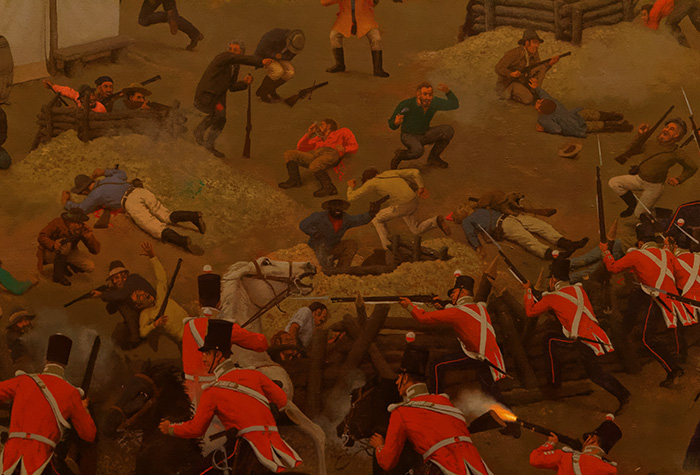
Eureka December 3 1854, (painted 1985-89) - detail / oil on canvas / George Browning (Australia, 1918-2000) / Art Gallery of Ballarat
Germans were among the rebel miners who took part in the Eureka Stockade rebellion on the Ballarat goldfields on 3rd December, the closest Australia has come to a civil revolution. The miners were protesting against the cost of the miners licence and the arrogant and poor administration of the goldfields by the conservative government authorities. One of the rebels was Friedrich Wern from Hannover, a flamboyant and perhaps self-important man, who had moved a successful motion at a mass meeting on 29th November that licences be burned. When the troopers stormed the Stockade with overwhelming numbers, among the 30 dead diggers were three Germans: Wilhelm Emmermann from Petersberg, Johann Hafele, a blacksmith from Württemberg, and Eduard Thönen, a Prussian from Elberfeld (the "lemonade man").
The Victorian government mistakenly believed that Friedrich Wern (Vern) was the leader of the uprising and offered £500 reward for his capture.
More about Vern... (including the Wanted poster).
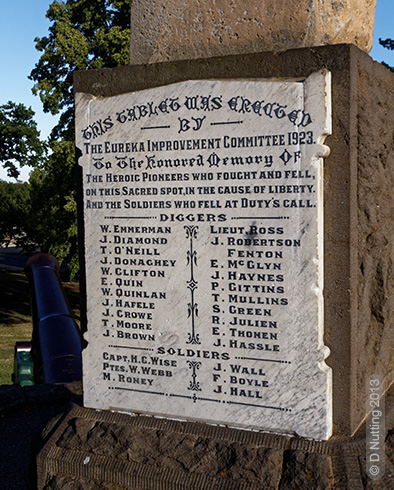
Memorial plaque with the names of the dead, Eureka Stockade Monument, Eureka St, Ballarat
Edward Thonen (Eduard Thönen)
Thönen was born on 26th May 1827 in Elberfeld, Prussia (Elberfeld is now part of Wuppertal - on 1st August 1929 Elberfeld was merged with four other towns to form today's city of Wuppertal in the eastern Rhineland). He trained to be a merchant, and at the age of 23 travelled to England on the ferry from Ostend in Belgium to Dover. He arrived in England on 10th December 1850. Almost all British and Australian newspaper reports about him spelled his name 'Thonen', without the German Umlaut over the letter 'o'. Thonen excelled at languages. He demonstrated fluency in several foreign languages, including French, Dutch, English, and Spanish, with the possibility of his linguistic repertoire extending beyond this list. Thonen was one of 9,566 residents of London in the 1851 census who were recorded as having been born in Germany. Shortly after arriving in London he was robbed of most of his valuables, but he found a job as a clerk, working for a diamond merchant, however, it was difficult for him to make ends meet, as his salary was low. Thonen decided to steal from his employers and use the money to escape to America.
He nearly made it to America, but the British police chased his ship and he was caught 60-80 miles off the Welsh coast and brought back to London. A large number of newspapers in Britain and Ireland reported on Thonen's diamond robbery.
It's surprising that Thonen was sentenced to only one year in prison for the diamond robbery. He returned to his family in Germany in the summer of 1852 and must have heard about the gold discoveries in south-eastern Australia. He decided to go to Australia, and as he was a reservist in a unit of the Prussian army (the 'Landwehr-Bataillon Essen'), he needed to get permission from his military unit to emigrate. He received this permission, however it is not known exactly when he arrived in Australia. The researchers Bamberger and Young have concluded that Thonen probably arrived in Victoria in the second half of 1853, and then moved to Ballarat shortly after his arrival.
Thonen had received basic military training in the Prussian army. He had the respect of other diggers in the stockade and was allocated one of the leadership roles in the defence of the stockade. The Italian revolutionary Carboni, who was among the rebel diggers before the battle, and who wrote a book about thee events at Ballarat, described how Thonen died from being hit in the mouth by bullets.
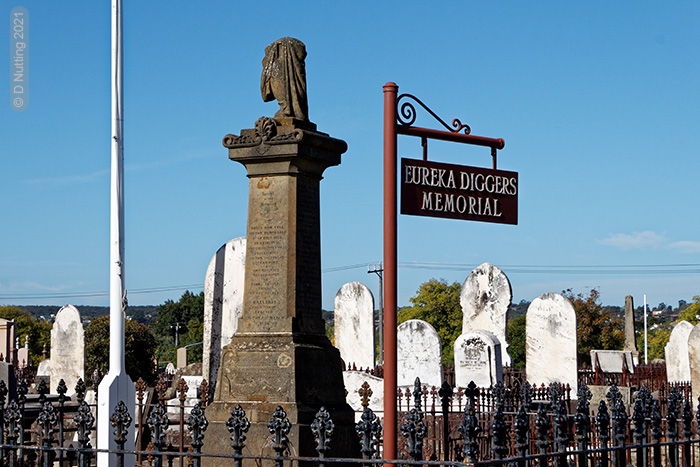
Eureka memorial in the Ballarat Old Cemetery
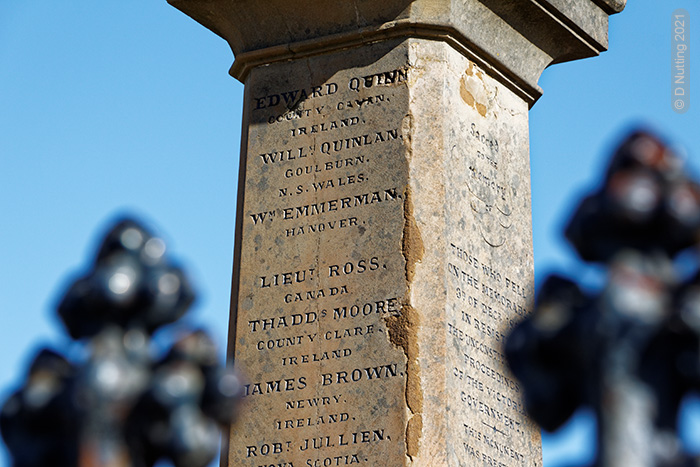
Eureka memorial in the Ballarat Old Cemetery
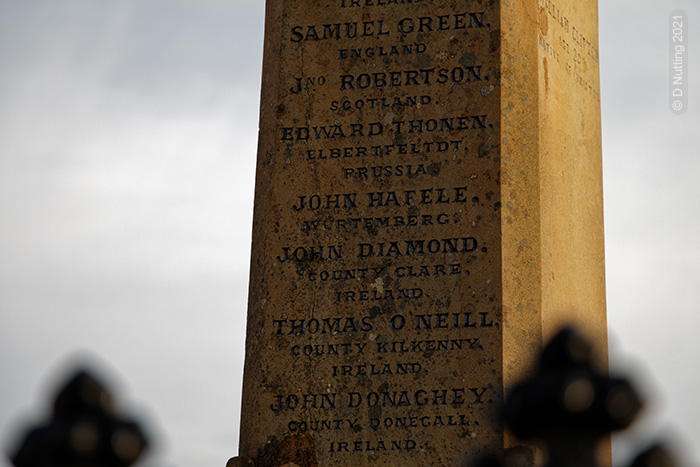
Eureka memorial in the Ballarat Old Cemetery, view from another side
John Hafele
A German blacksmith is also mentioned by Rafaello Carboni - this blacksmith worked hard making pikes for the rebels in the days leading up to the government attack on the stockade. Some researchers consider him to be Johann Hafele, after whom one of the footpaths in the old cemetery at Ballarat is named (Hafele Drive). He was a large strong man, and the military historian and author Gregory Blake believes it is very possible that Johann Hafele already had some experience of war, that he was one of the foreigners who fought in the Mexican-American War (1846-48), based on comments made by Raffaello Carboni, written after the Eureka battle. The United States Army of that time included many Germans. Hafele was killed in the stockade; researchers believe it is likely that it was his body that some eye-witnesses described as being pierced by many bullet holes and bayonet wounds, some of which happened when he was already dead. One eye-witness described how the top of the blacksmith's skull was practically sliced off by a blow from a soldier's sword.
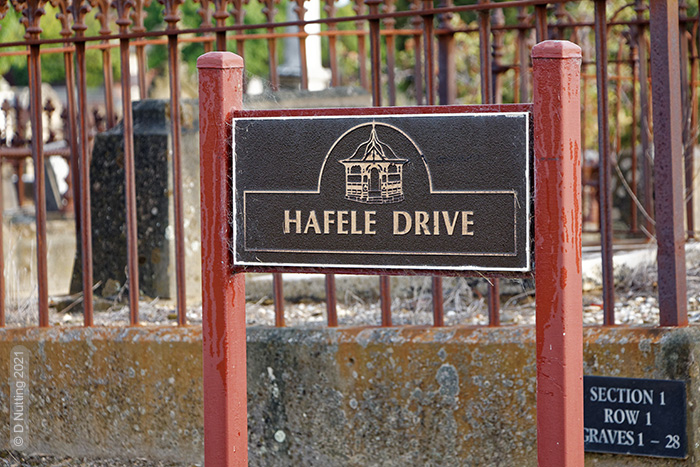
A pathway sign in the Ballarat Old Cemetery (Hafele Drive)
As the bodies of dead rebels were being transported away for temporary burial, eye-witnesses reported how a small dog, presumably belonging to the German blacksmith, cried piteously and stood on its dead owner's bloodied chest and refused to leave him. Some researchers think it may be possible that this German blacksmith was in fact one of the other dead Germans whose name is on the Eureka memorials, namely Wilhelm Emmermann. Johann Hafele's name is also listed on the memorials for the dead rebels. His name was originally very probably spelled Häfele, with the German Umlaut on the first vowel; that spelling is far more common in Germany than ‘Hafele’).
The Ballarat Star reported in 1888 on the reunion of three old friends in Armstrong Street, Ballarat, who had been in Ballarat when the Eureka battle occurred. These three men, Charley, Mick and Bill, told the newspaper what they remembered, as follows:
"Little Thoneman, the lemonade man, was shot, bayonetted, and sabred here on the right of the gully, and over there on the left lay the German blacksmith who made the pikes, with the top of his skull hanging by the scalp, and still living, his little terrier dog lying on his breast and refusing to leave his master."

The rebel diggers who were tried in court were defended free-of-charge by Melbourne's best lawyers and were all acquitted. Improvements in the administration of the goldfields and in the political life of the colony followed. Pictured is the famous flag of the Eureka Stockade, thought to have been designed by a Canadian digger called "Lieutenant" Ross (who died defending the Stockade) and made, according to Frederick Vern, by "two English ladies".
The Pictures Collection of the State Library of Victoria possesses a photographic print (photographer unknown) from a photo taken of a painted canvas titled Eureka Stockade by Izett Watson and Thaddeus Welch, circa 1890. The print was hand-painted in colour by Beryl Ireland, circa 1891. malten. You can see the picture in the State Library of Victoria's Pictures Collection [➽ H141890].
Sources:
Bamberger, D. & Young, A. (2023). Edward Thonen: a forgotten Eureka rebel. WikiTree Germany Connector's Challenge. Zeitgeschichtliche Sammlung, Zentrum für Stadtgeschichte und Industriekultur Wuppertal. Available here as PDF-file ![]() .
.
Blake, Gregory. (2012). Eureka Stockade : a ferocious and bloody battle. Newport, N.S.W. : Big Sky Publishing
Carboni, Raffaello. (1855). The Eureka Stockade. Melbourne : J P Atkinson and Co.
RENEWING THEIR YOUTH. (1888, September 22). The Ballarat Star (Vic. : 1865 - 1924), p.5 (Ballarat Star (Vic. : 1865 - 1924)). Retrieved March 7, 2024, from <http://nla.gov.au/nla.news-article209448532>
Kieza, Grantlee. (2013). Sons Of The Southern Cross: rebels, revolutions, Anzacs and the spirit of Australia's fighting flag. HarperCollins, Sydney. ISBN: 9780733331565 p.165 & p.177
Lodewyckx, Prof. Dr. A. (1932). Die Deutschen in Australien. Stuttgart: Ausland und Heimat Verlagsaktiengesellschaft. pp.78-79
Voigt, Johannes H. (1988). Australien und Deutschland. 200 Jahre Begegnungen, Beziehungen und Verbindungen. Hamburg (Germany): Institut für Asienkunde. p.25
| Top | Back
| Chronology | Issues
| Students | Site Map |
auf Deutsch |
| Primary Sources (in German) | Bibliography
| Search |
German Australia © D. Nutting 2001